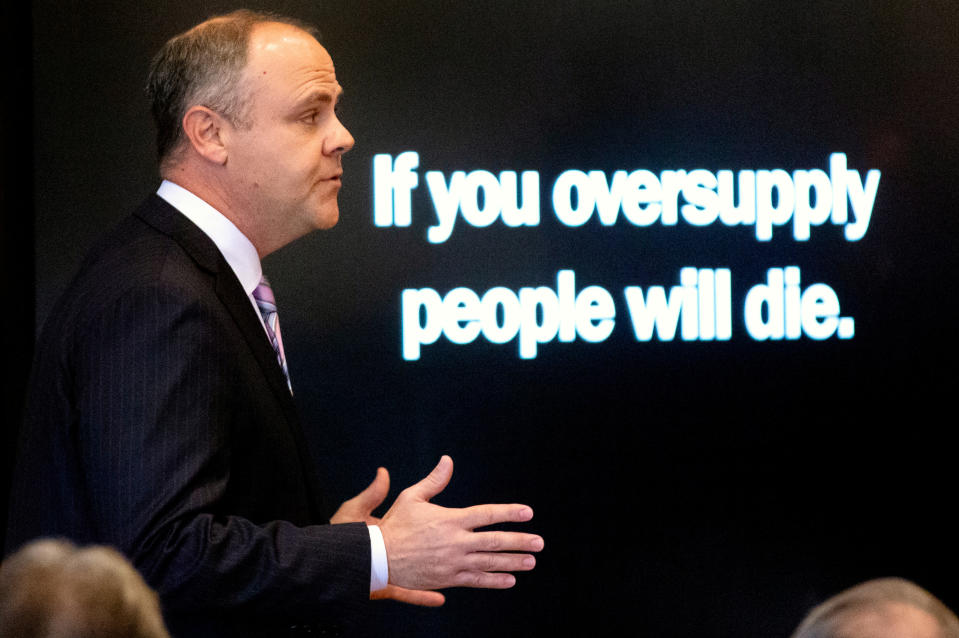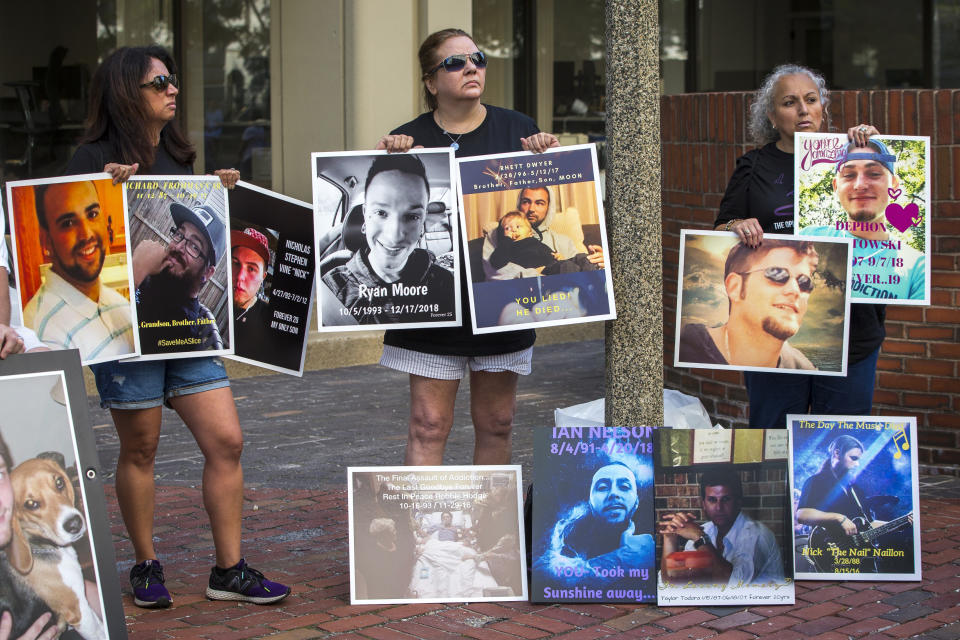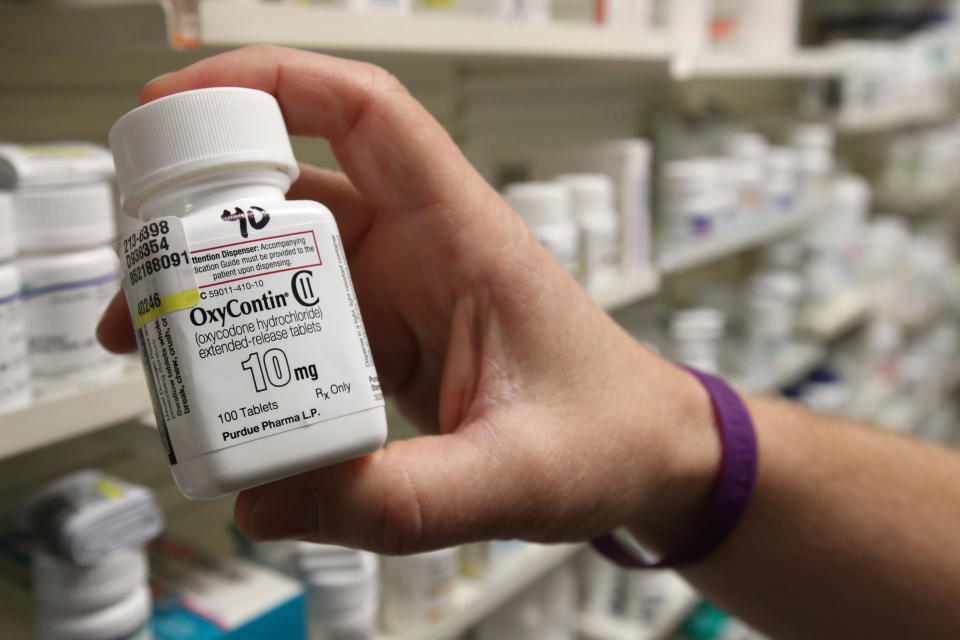'Public nuisance really just sounds bad': What the $572 million J&J fine means for opioid litigation
Handicappers looking to estimate costs for drugmakers embroiled in opioid litigation, now have one, possibly anomalous, case for extrapolating predictions.
In the first trial of more than 2,300 opioid cases pending across the U.S., an Oklahoma judge on Monday ordered Johnson & Johnson (JNJ) to pay $572 million for its role in marketing the prescription drugs.

Johnson & Johnson and other opioid marketers, manufacturers, and distributors face 48 similar lawsuits from other states, plus at least 2,277 cases filed by cities, local governments and private parties, consolidated in multidistrict litigation in federal district court for the Northern District of Ohio.
While it may be tempting to use Oklahoma’s more than half-a-billion dollar award as a multiplier for J&J’s potential fallout, the implications of Monday’s judgement are not so straightforward.
Is the opioid crisis a ‘public nuisance’?
For one, the underlying legal theory of public nuisance, successfully waged against J&J in Oklahoma, has more limited application in other jurisdictions. J&J has pledged to appeal the Oklahoma decision, in part based on its position that the judge misapplied public nuisance law. In Ohio, Judge Dan Aaron Polster, who is overseeing the multidistrict litigation and presiding over its first case set for trial, has yet to decide whether the theory will be permitted under Ohio law.

“In many states, they follow the traditional rules that [public nuisance] has to involve the use of real property, or damage to real property,” University of Kentucky law professor Richard C. Ausness told Yahoo Finance. “Oklahoma’s statute is very loosely written, to put it mildly. So the court sort of felt that it wasn't limited by that property restriction.”
Ausness said he thinks it will be difficult for opioid plaintiffs to successfully wage public nuisance claims in states that follow the traditional approach. A North Dakota court recently declined to permit the theory against Oxycontin manufacturer Purdue Pharma. However, public nuisance claims did move Philip Morris and Reynolds American in 1998 to reach a historic $246 billion global settlement in multidistrict tobacco litigation before cases went to trial.
“We don’t really know what Polster’s view of it is,” Andrew Pollis, a law professor at Case Western University law school, said. The judge is expected to issue a decision on whether the public nuisance and other claims may go forward after arguments on Sept. 5.
Second, damages in Oklahoma were limited to address its single claim of public nuisance and therefore calculated to abate problems stemming from the nuisance: opioid abuse and addiction. Other, untested, legal theories could add to the level of risk for defendants should they be held liable in other cases.
Finally, the ruling in Oklahoma, unlike cases already scheduled for trial in the multidistrict litigation, was rendered by a judge, not a jury.
‘In the neighborhood of $30 billion’
The apples-to-oranges factors may leave the $572 million judgement against J&J an imperfect litmus test for verdicts to come, though attempts to quantify damages are inevitable.
“I think, if there was a global settlement, which is unlikely, at least anytime soon...if they got all 24,000 or so — municipalities and counties, plus the states — I think it would be in the neighborhood of $30 billion,” Ausness said about a settlement that would include all opioid defendants. “And I say that simply because the drug companies, with perhaps the exception of Johnson & Johnson, just simply don't have much more money than that.”
The $572 million, in J&J’s case, multiplied by 49 or 50 states, has no legal basis for estimating potential damages of $30 billion.
“All it is, is one jurisdiction’s calculation of abatement costs,” he said. However, the $572 million number could potentially affect public sentiment, which could in turn, could influence a jury, he noted.

Oklahoma’s attorney general sought more than $17 billion from J&J, which chose to stand trial as the lone defendant after the state reached settlements with former co-defendants, Purdue Pharma and Teva Pharmaceutical Industries (TEVA) for $270 million and $85 million, respectively. J&J, which was responsible for about 1% of the prescription opioids sold in the state, and also sold raw opioid ingredients to the industry at large, was left with a comparatively larger share of damages.
J&J argued that Oklahoma did not show evidence to demonstrate that any citizen of the state became addicted to any opioid product sold by J&J, Pollis said.
‘Public nuisance really just sounds bad’
Aside from public nuisance, there are alternate legal theories waiting to be tested. Thousands of remaining cases include allegations of fraud, misrepresentation, and violations of state and federal statutes, all of which could fail, prevail, or result in outcomes exceeding or falling short of the Oklahoma judgment.
“Public nuisance really just sounds bad,” Ausness said, adding that plaintiffs’ attorneys carefully consider public perception in disputes as widely reported and voluminous as the opioid litigation. One particular reason Oklahoma’s outside counsel dropped additional claims against J&J was based on a strategy that public nuisance theory, alone, would keep the case “cleaner.”
Wall Street’s reaction to the Oklahoma judgement has so far signaled that investors view the outcome as a sigh of relief. The company's shares rose on news of the ruling, and have since remained mostly flat.
On Tuesday, NBC reported that Purdue Pharma had offered between $10 billion and $12 billion to settle its outstanding opioid cases, which would include the company filing for Chapter 11 reorganization.
In a statement the company said, “While Purdue Pharma is prepared to defend itself vigorously in the opioid litigation, the company has made clear that it sees little good coming from years of wasteful litigation and appeals.”
As in the Oklahoma case, the Ohio plaintiffs, Summit and Cuyahoga county, are seeking to hold J&J responsible for the way it marketed opioid products. In addition to public nuisance claims, they are also seeking to go forward on violations of RICO and The Ohio Corrupt Practices Act. Actavis Pharma (Allergan is successor in interest), Cephalon (now part of Teva), Endo Pharmaceuticals, Insys Therapeutics, and Mallinckrodt Pharmaceuticals are also named as “marketing” defendants. Endo reached an agreement, in principle, to settle out of the case, as reportedly did Allergan.
“I don't think this is a proper use of our justice system,” Pollis said. “I think the parties are too far removed from the injury, the damage and the failure is on the part of the political branches of our government, executive and legislative, to do their jobs to prevent the crisis.”
On appeal, unless there's a clear mistake of law, in most instances the deck is stacked against the party appealing the case, Ausness said.
“This judgment is a misapplication of public nuisance law that has already been rejected by judges in other states,” Michael Ullmann, general counsel for J&J said in a statement. “The unprecedented award for the State’s ‘abatement plan’ has sweeping ramifications for many industries and bears no relation to the Company’s medicines or conduct.”
Alexis Keenan is a reporter for Yahoo Finance. Follow Alexis on Twitter @alexiskweed.
Read the latest financial and business news from Yahoo Finance
Follow Yahoo Finance on Twitter, Facebook, Instagram, Flipboard, SmartNews, LinkedIn, YouTube, and reddit.


